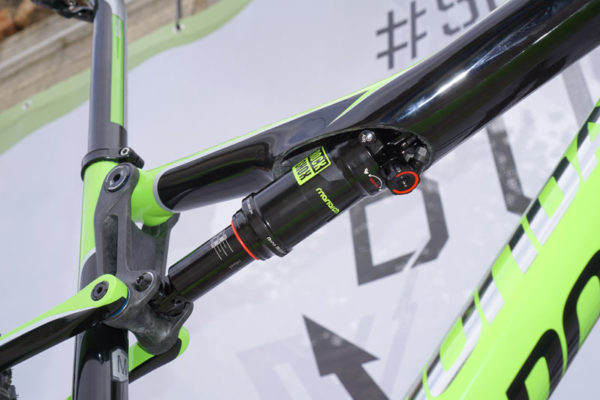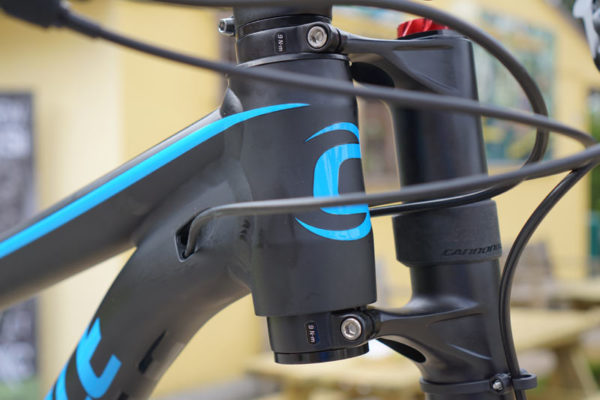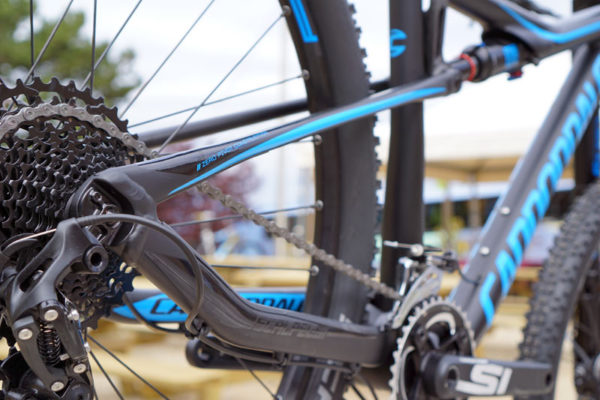Cross country courses are getting more technical and more challenging. If you haven’t been to a World Cup race lately to see for yourself, you can simply take the fact that more and more of the top racers are aboard full suspension as evidence of that. Cannondale’s no newcomer to racing full suspension at the top level, having put riders like Kashi Leuchs, Tinker Juarez and Christoph Sauser on them as far back as 2002.
And they’ve done it by making incredibly lightweight bikes, particularly the more recent full carbon versions of the Scalpel. But, just making something super light and stiff is no longer enough. They needed a bike could excel in rocky terrain like Nove Mesto and Cairns.
Because, as they say, cross country races are still won on the climbs, but can be lost on the descents. It’s time to add another X to XC…
Their goal was to provide a lightweight, efficient, hardtail alternative that can crush any marathon or stage race, too. It’s easy to make something more aggressive by simply adding more travel, but they wanted to keep the Scalpel it as a pure XC machine since the Habit sits so close to it with 120mm travel. They also wanted it to be durable and user friendly, with features like fitting two water bottles on the 29er frame and using common tools to make adjustments and repairs. And it had to be the best bike for all riders, with size specific geometry, wheel diameters (27.5 for XS/S/M, 29er for M/L/XL) and fork offset.
That geometry was the most dramatic change in making the Scalpel a more capable bike. Keeping with modern trends, it’s longer and slacker, but the rear end is 9m shorter which essentially shifts the wheelbase forward under the rider. Wheelbase grows slightly, too, which enhances high speed stability. The head angle on all sizes is 69.5º, and the Lefty gets a 55mm offset on the 29ers and 50mm offset on 27.5. The custom fork offset was something they could do easily because they control the fork’s design, and that’s why you’ll find a Lefty on every model of the new Scalpel Si.
They call this combination of a slacker head angle and longer fork offset Outfront Geometry. It creates good high speed stability, makes it easier to control on the descents, but still provides snappy slow speed handling because the front tire’s trail is very short.
In the rear, they use their AI Asymmetric Integration, which was introduced on the F-Si hardtail and allows for very short chainstays (435mm). The challenge with super short stays is that the chainring and tire both compete for space at the same place on the bike. You could simply limit the bike to 1x drivetrains, or limit tire size, but those are both compromises. Or, you could do Boost, which adds 3mm to the driveside. But Cannondale didn’t want to compromise, and 3mm just wasn’t enough. So they pushed the drivetrain outboard a full 6mm, giving them all of Boost’s full 6mm increase on the driveside. That opened up room for most 2.35″ tires and 2x drivetrains.
AI does shift the wheel over, too, which would have created some potentially weird tracking issues, so they simply dished the wheel back to the left. That ended up with equal length spokes and spoke angle on both sides of the wheel.
And it does this all with a 142mm thru axle hub, not Boost. Look for AI to make its way to a lot more of their bikes in the future.
Fit is almost identical to their F-Si hardtail, just with 10mm shorter stems, so their pros can achieve the same fit and feel between the two. It also runs on a more even stack/reach size progression than before.
Fit and geo wasn’t the only thing that changed. They wouldn’t be Cannondale if they didn’t find a few ways to shed grams and make it stiffer. The rear triangle continues to use their flex seatstays to eliminate a rear pivot, but the prior design the rear brake sat up on the seatstay, which required more material to reinforce that section. Now, it’s moved down to the chainstay. That saved a lot of weight, and it let them better tune the seatstay to do its job of flexing. It also made for cleaner hose routing.
Each half of the rear triangle is molded as a single piece, with continuous fibers running from the top of the seatstay to front of the chainstay. That lets them really control the fiber layup to resist torsional flex and control vertical flex. One challenge with using a design like this is keeping each side of the frame working in sync with the other.
On the prior design, they clamped the front of the stays to a thru axle, forcing them to pivot in sync. And they used the double bearings and pivot from the Trigger and Jekyll Over Mountain bikes. But that was overkill for an XC bike, so they developed the Lock’r.

Lock’r uses an expanding axle to lock itself into the swing arm rather than clamp the swing arm onto the axle. This method not only saves weight (they claim it’s 6% lighter and 10% stiffer), but it keeps everything perfectly round (things ovalize when they get clamped, which could put uneven pressure on the bearings) and lets you adjust it with a multitool on the side of the trail. The axle is a two-part system. The outer (actual) axle threads into the stays and controls bearing preload. The inner bolt then threads together inside it to expand the axle edges into the stays and lock everything in place.
Once assembled, the design creates a box between the four locking bolts, which makes a very stiff structure between the lower main pivot and the lower shock pivot.
Lastly, chainstays are 9mm shorter but wider and fatter, which contributes greatly to improved stiffness.
Any talk of a new Cannondale bike almost has to have a conversation about saving weight. Surprisingly, they said being lightest wasn’t a priority for them on this project, it’s just something they do naturally. So they wanted to add all of the improved performance and stiffness and if they came in at the same weight as before they’d have been happy. As it turns out, they came in 102g lighter for a size large.
Every tube on the front triangle is different, too. Rather than have a fixed head tube height, they now offer different heights, which mean making four different Leftys instead of the prior one-size-fits-all version. Other sections were heavily refined, like making the top tube much narrower, and there’s much more efficient use of structural carbon at the top shock mount since its nested into the tube rather than jutting out below it.
The link went from machined aluminum to molded long-sheet carbon, which saved just over 100g on its own.
Other improvements include modular internal cable routing that makes installation and maintenance very easy. Inserts (for the carbon frames only) sandwich the cable house/hose/wire inside, then bolt into the frame. These maintain tension on everything so they won’t rattle around inside the bike, and let you dial the amount of exposed cable or hose loop and keep it set just the way you like it. Small plugs close unused holes for a super clean appearance.
The Di2 battery gets a custom mount that slides into the top tube in front of the shock, then uses the upper shock mount to secure the battery holster. This frees up the seat tube area for a dropper post.
All models come equipped with a Rockshox Monarch shock using only their two-position on/off lockout. Cannondale’s suspension engineer, Jeremiah Boobar, formerly worked for Rockshox and said for this application, the simpler damping tune worked better and was preferred by their athletes. They’re also using the standard air can, not the larger Debonair. To make it fit inside the new top tube, they had Rockshox create a custom hydraulic lockout banjo to streamline the appearance.
It’s using an 83mm BB shell. On bikes spec’d with their Hollowgram cranks, that means their BB30A crank arms that take away the imbalance between arm/ankle clearance, so both have 9mm clearance and look identical. For the SRAM Eagle equipped top model, SRAM is only selling to OEM in complete groups for now, so they’re simply running a wider crankset, which does stretch the Q-factor slightly. Hollowgram equipped bikes maintain a standard Q-factor.
All models get a Lefty, so there’s no compromise on the handling as you drop down the price spectrum.
The Lefty uses Rockshox’s Solo Air system, but with Cannondale’s own damping circuits. Depending on model, you’ll get several lockout options. Top models get the FullSprint dual hydro lockout, others switch to a single front remote lockout with the shock’s lockout lever sitting under the top tube.
The top level BallisTec carbon frame with shock, hardware and rear axle comes in at a claimed 2,118g for size large. That includes about 83g of hardware, about 30-100g of paint depending on color and graphics (darker is lighter, FYI), plus the thru axle and rear shock.
The carbon Scalpel wasn’t the only one to see improvements. While there’s only one alloy Scalpel Si offered at launch, it gets some major upgrades, too.
Alloy version made the switch to flex stays – there’s no longer a pivot near the rear axle. They had to really re-work the design because alloy doesn’t have the same fatigue life as carbon when used in an intentionally flexing manner. So, for this Scalpel, they actually designed the suspension with alloy in mind, rather than design the bike’s kinematics around carbon first, then figure out how to make it work on aluminum.
So, the new Scalpel minimizes any spring or rebound effect that could influence the suspension, and it moves in a way that are well within the material’s fatigue life parameters. Think of it like an airplane wing. They know how much it’s going to flex in a given flight and what the limit is, so they design it to handle the limit+1. Same here.
They used the same flow modeling design as CAAD12, with tubes optimized from the inside out to make the most of every radius and taper, all through FEA. The result is a bike that’s 300g lighter than prior alloy frame.
Head over to this post for the full spec and build options, pricing and more. Carbon models should be available by mid May, alloy will be early summer.




















